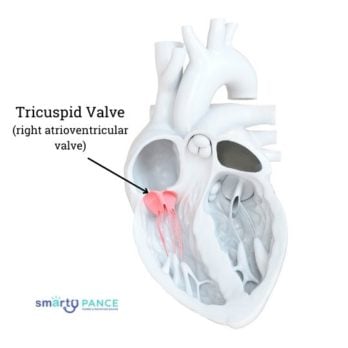Podcast Episode 94: Murmurs Made Incredibly Easy (Part 4 of 5) – Tricuspid Stenosis
Description
<figure class="alignright size-medium">
 </figure>
</figure>Welcome to episode 94 of the Audio PANCE and PANRE PA board review podcast.
Today is part four of this fabulous five-part series with Joe Gilboy PA-C, all about cardiac murmurs. In this week’s episode of the Audio PANCE and PANRE podcast, we continue our discussion of cardiac murmurs with a focus on the tricuspid valve.
We’ll cover the ins and outs of tricuspid valve stenosis and learn how to identify it and differentiate it from other types of murmurs.
If you haven’t already, make sure to listen to our previous podcast episode where we covered aortic valve murmurs and mitral valve murmurs, and pulmonic valve murmurs.
The Tricuspid Valve
The tricuspid valve, or right atrioventricular valve, is a one-way valve that sits between the right atrium and right ventricle of the heart. It is essential for right ventricular filling and for preventing the backflow of blood from the right ventricle into the right atrium when the right ventricle contracts during systole.
When functioning properly, the tricuspid valve is a passive structure that opens and closes in response to the pressure of the blood flowing through the heart.
The right atrium receives deoxygenated blood from the superior and inferior vena cava. The tricuspid valve which separates the right atrium from the right ventricle opens during ventricular diastole, allowing the deoxygenated blood to flow from the right atrium into the right ventricle, and closes during ventricular systole preventing the backflow of blood from the right ventricle into the right atrium as the right ventricle contracts to pump blood into the lungs out through the pulmonary artery.
Tricuspid Valve Stenosis
Tricuspid stenosis is a narrowing of the tricuspid valve or one of its three leaflets.
If the tricuspid valve is narrowed or stenotic, it will not open properly during diastole, increasing the volume of blood in the right atrium. When the right ventricle contracts the stiffened tricuspid valve also fails to close completely and tricuspid regurgitation develops.
Nearly all cases are caused by rheumatic fever.
Podcast Episode 94: Murmurs Made Incredibly Easy (Part 4 of 5) – Tricuspid Valve Stenosis
Below is a transcription of this podcast episode edited for clarity.
- You can download and listen to past FREE episodes here, on iTunes, Spotify, Google Podcasts, Stitcher, Amazon Music, and most podcasting apps.
- You can listen to the latest episode and access even more resources below.
Welcome everybody, this is Joe Gilboy PA-C and I work with Stephen Pasquini at Smarty PANCE. Today, we will continue this series on heart murmurs. Today’s topic is tricuspid stenosis.
So, sit back, listen to my voice, and try not to take notes. Don’t do anything other than just listen and follow my logic. I promise you, when this is all said and done, you’ll be looking at heart murmurs and more specifically, tricuspid stenosis in a vastly different light. I want you to view the tricuspid valve. Just think about it. There you are the right atria. The tricuspid valve opens during diastole and closes during systole.
There’s all your blood in the right ventricle, and it goes out through the pulmonary valve to get oxygenated out in the lungs.
So now, I want you to think about this for a second. I have a tricuspid valve that is stenotic. It’s stiff and hard to open.
When are you going to have problems opening this valve? During diastole? Or during systole?
You are going to have problems with this during diastole because that’s when the tricuspid valve is supposed to open up. Because it’s supposed to be closed during systole.
So, it’s a diastolic murmur, it’s considered a mid-diastolic murmur.
Now give this some more thought. Okay, so you’re in the right atria – Is it easier or harder to push through this stenotic valve?
Oh, it’s a lot harder. And so, where’s the blood flow going to back up to? Into the right atrium and now that right atrium, it’s going to have all this increased pressure going into it. So now what are you going to get? You are going to get right atrial enlargement!
Here is another question – If the right atrium is having a tough time pushing blood through the stenotic valve then where’s this extra blood going to back up to? The right side of the body. Exactly! So, I’m going to have JVD and I’m going to get pedal edema? You are going to get right-sided heart failure with tricuspid stenosis.
Can I ask another question? How’s your blood flow to your right ventricle? It is diminished. Well, then how’s your blood flow to the pulmonary area? That’s diminished! How’s your oxygenation? That’s also diminished. So how are you feeling? I’m short of breath. Exactly. And you are short of breath not because you’re in heart failure. You’re short of breath because you’re just not getting blood to oxygenate. Exactly.
So, tricuspid stenosis is on the right side. One more time – Inspiration right. Expiration left. Inspiration right. Expiration left that if you didn’t get it the first two times. Let’s try the third time. Inspiration right. Expiration left.
Hi, I’m tricuspid stenosis, which side of the heart am I on the right or left? I’m on the right. So, tricuspid stenosis is going to sound louder with inspiration. Exactly.
What’s the party maneuver where all the blood flow comes back home and everybody’s just partying as you get more blood flow back home – squatting. What else could make tricuspid stenosis sound louder? Squatting! Exactly!
Squatting is a high-volume maneuver and will make the murmur of tricuspid stenosis sound louder.
What are my low-volume maneuvers? What are the maneuvers that take blood out of my heart? Standing in Valsalva!
So, what would make tricuspid stenosis go away? Standing and Valsalva are low volume maneuvers and will decrease the sound of tricuspid valve stenosis.
So, I have a right-sided heart murmur. It’s diastolic and is considered mid-diastolic. Where am I going to put my stethoscope?
You see, there’s only one thing on the right – that’s the aortic valve at the right second intercostal space, right that we all memorized in school. So, everybody’s on the left.
The left upper sternal space – that’d be pulmonic. But what is on the left – everybody else?
So hi, you’re the tricuspid valve, where are you? I’m on the left… Exactly! You’re going to be on the left at the lower sternal border.
So now I have this mid-diastolic murmur. Left sternal border that sounds louder with inspiration => goes away with expiration => left. It’s going to sound louder with squatting and is going to go away with standing and Valsalva – these are my low volume maneuvers.
And how did you get this? Usually, the most common cause of tricuspid stenosis is rheumatic fever, is it not?
So now, let’s pull back, and let’s look at this from 30,000 feet.
- I’ve got a stenotic valve over there on the right side. Who is it? It’s the tricusp








